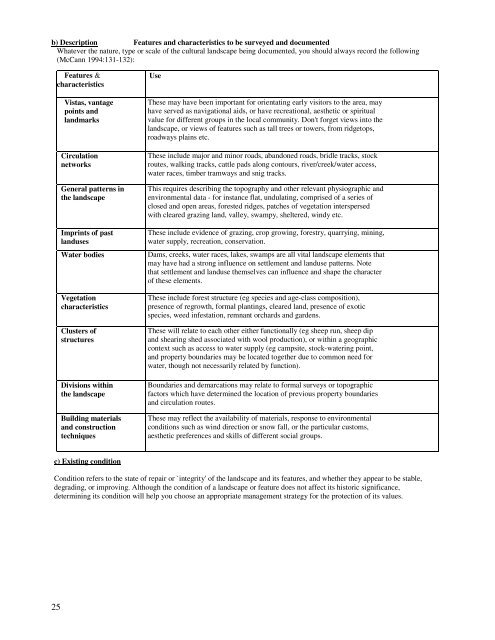Cultural Landscape Management - Australian Alps National Parks
Cultural Landscape Management - Australian Alps National Parks
Cultural Landscape Management - Australian Alps National Parks
Create successful ePaper yourself
Turn your PDF publications into a flip-book with our unique Google optimized e-Paper software.
) Description Features and characteristics to be surveyed and documentedWhatever the nature, type or scale of the cultural landscape being documented, you should always record the following(McCann 1994:131-132):Features &characteristicsVistas, vantagepoints andlandmarksCirculationnetworksGeneral patterns inthe landscapeImprints of pastlandusesWater bodiesVegetationcharacteristicsClusters ofstructuresDivisions withinthe landscapeBuilding materialsand constructiontechniquesUseThese may have been important for orientating early visitors to the area, mayhave served as navigational aids, or have recreational, aesthetic or spiritualvalue for different groups in the local community. Don't forget views into thelandscape, or views of features such as tall trees or towers, from ridgetops,roadways plains etc.These include major and minor roads, abandoned roads, bridle tracks, stockroutes, walking tracks, cattle pads along contours, river/creek/water access,water races, timber tramways and snig tracks.This requires describing the topography and other relevant physiographic andenvironmental data - for instance flat, undulating, comprised of a series ofclosed and open areas, forested ridges, patches of vegetation interspersedwith cleared grazing land, valley, swampy, sheltered, windy etc.These include evidence of grazing, crop growing, forestry, quarrying, mining,water supply, recreation, conservation.Dams, creeks, water races, lakes, swamps are all vital landscape elements thatmay have had a strong influence on settlement and landuse patterns. Notethat settlement and landuse themselves can influence and shape the characterof these elements.These include forest structure (eg species and age-class composition),presence of regrowth, formal plantings, cleared land, presence of exoticspecies, weed infestation, remnant orchards and gardens.These will relate to each other either functionally (eg sheep run, sheep dipand shearing shed associated with wool production), or within a geographiccontext such as access to water supply (eg campsite, stock-watering point,and property boundaries may be located together due to common need forwater, though not necessarily related by function).Boundaries and demarcations may relate to formal surveys or topographicfactors which have determined the location of previous property boundariesand circulation routes.These may reflect the availability of materials, response to environmentalconditions such as wind direction or snow fall, or the particular customs,aesthetic preferences and skills of different social groups.c) Existing conditionCondition refers to the state of repair or `integrity' of the landscape and its features, and whether they appear to be stable,degrading, or improving. Although the condition of a landscape or feature does not affect its historic significance,determining its condition will help you choose an appropriate management strategy for the protection of its values.25
















